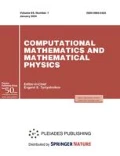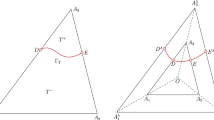Abstract
The pressure boundary conditions for the steady-state solution of the incompressible Navier–Stokes equations with the collocated finite-volume method are discussed. This work is based on inf-sup stable coupled flux approximation. The flux is derived based on the linearity assumption of the velocity and pressure unknowns that yields one-sided flux expressions. Enforcing continuity of these expressions on internal interface we reconstruct the interface velocity and pressure and obtain single continuous flux. As a result, the conservation for the momentum and the divergence is discretely exact. However, on boundary interfaces additional pressure boundary condition is required to reconstruct the interface pressure.


Similar content being viewed by others
REFERENCES
K. Terekhov, “Fully-implicit collocated finite-volume method for the unsteady incompressible Navier–Stokes problem,” in Numerical Geometry, Grid Generation, and Scientific Computing (Springer, Cham, 2021), pp. 361–374.
P. M. Gresho, “On the theory of semi-implicit projection methods for viscous incompressible flow and its implementation via a finite element method that also introduces a nearly consistent mass matrix: Part 1. Theory,” Int. J. Numer. Methods Fluids 11 (5), 587–620 (1990).
K. Terekhov, “Collocated finite-volume method for the incompressible Navier–Stokes problem,” J. Numer. Math. 29 (1), 63–79 (2021).
A. Bouchnita, K. Terekhov, P. Nony, Yu. Vassilevski, and V. Volpert, “A mathematical model to quantify the effects of platelet count, shear rate, and injury size on the initiation of blood coagulation under venous flow conditions,” PLoS One 15 (7), e0235392 (2020).
Yu. Vassilevski, K. Terekhov, K. Nikitin, and I. Kapyrin, Parallel Finite Volume Computation on General Meshes (Springer International, Berlin, 2020).
O. A. Ladyzhenskaya, The Mathematical Theory of Viscous Incompressible Flow (Gordon and Breach, New York, 1969).
V. I. Lebedev, “Difference analogues of orthogonal decompositions, basic differential operators and some boundary problems of mathematical physics I,” USSR Comput. Math. Math. Phys. 4 (3), 69–92 (1964).
F. H. Harlow and J. E. Welch, “Numerical calculation of time-dependent viscous incompressible flow of fluid with free surface,” Phys. Fluids 8 (12), 2182–2189 (1965).
M. A. Olshanskii, K. M. Terekhov, and Yu. V. Vassilevski, “An octree-based solver for the incompressible Navier–Stokes equations with enhanced stability and low dissipation,” Comput. Fluids 84, 231–246 (2013).
B. Perot, “Conservation properties of unstructured staggered mesh schemes,” J. Comput. Phys. 159 (1), 58–89 (2000).
C. M. Rhie and W. L. Chow, “Numerical study of the turbulent flow past an airfoil with trailing edge separation,” AIAA J. 21 (11), 1525–1532 (1983).
R. Brewster, C. Carpenter, E. Volpenhein, E. Baglietto, and J. Smith, “Application of CD-Adapco best practices to NESTOR OMEGA MVG benchmark exercises using STAR-CCM+,” Proceedings of NURETH-16 (Chicago, IL, 2015).
ANSYS CFX-Solver Theory Guide: ANSYS CFX Release 11.0 (2006).
J. D. Marković, N. Lj Lukić, J. D. Ilić, B. G. Nikolovski, M. N. Sovilj, and I. M. Šijački, “Using the ANSYS FLUENT for simulation of two-sided lid-driven flow in a staggered cavity,” Acta Period. Technol. 43, 169–178 (2012).
D. R. Rutkowski, A. Roldán-Alzate, and K. M. Johnson, “Enhancement of cerebrovascular 4D flow MRI velocity fields using machine learning and computational fluid dynamics simulation data,” Sci. Rep. 11 (1), 1–11 (2021).
F. P. Kärrholm, “Rhie–Chow interpolation in OpenFOAM” (Department of Applied Mechanics, Chalmers University of Technology, Goteborg, Sweden, 2006).
K. Terekhov and Yu. Vassilevski, “Finite volume method for coupled subsurface flow problems: I. Darcy problem,” J. Comput. Phys. 395, 298–306 (2019).
K. Terekhov, “Multi-physics flux coupling for hydraulic fracturing modelling within INMOST platform,” Russ. J. Numer. Anal. Math. Model. 35 (4), 223–237 (2020).
L. Agélas, R. Eymard, and R. Herbin. “A nine-point finite volume scheme for the simulation of diffusion in heterogeneous media,” Compt. Rend. Math. 347, 673–676 (2009).
K. Terekhov, B. Mallison, and H. Tchelepi, “Cell-centered nonlinear finite-volume methods for the heterogeneous anisotropic diffusion problem,” J. Comput. Phys. 330, 245–267 (2017).
K. Terekhov, “Cell-centered finite-volume method for heterogeneous anisotropic poromechanics problem,” J. Comput. Appl. Math. 365, 112357 (2020).
K. Terekhov and H. Tchelepi, “Cell-centered finite-volume method for elastic deformation of heterogeneous media with full-tensor properties,” J. Comput. Appl. Math. 364, 112331 (2020).
P. M. Gresho and R. L. Sani, “On pressure boundary conditions for the incompressible Navier–Stokes equations,” Int. J. Numer. Methods Fluids 7 (10), 1111–1145 (1987).
K. Terekhov, “Parallel multilevel linear solver within INMOST platform,” in Supercomputing, Ed. by V. Voevodin and S. Sobolev (Springer, Cham, 2020), pp. 297–309.
K. Terekhov and Yu. Vassilevski, “INMOST parallel platform for mathematical modeling and applications,” in Supercomputing, Ed. by V. Voevodin and S. Sobolev (Springer, Cham, 2020), pp. 230–241.
K. Terekhov and Yu. Vassilevski, “Mesh modification and adaptation within INMOST programming platform,” in Numerical Geometry, Grid Generation, and Scientific Computing (Springer, Cham, 2019), pp. 243–255.
C. R. Ethier and D. A. Steinman, “Exact fully 3D Navier–Stokes solutions for benchmarking,” Int. J. Numer. Methods Fluids 19 (5), 369–375 (1994).
U. Ghia, K. N. Ghia, and C. T. Shin, “High-Re solutions for incompressible flow using the Navier–Stokes equations and a multigrid method,” J. Comput. Phys. 48 (3), 387–411 (1982).
Funding
This work was supported by the Russian Science Foundation through the grant 19-71-10094.
Author information
Authors and Affiliations
Corresponding author
Ethics declarations
The author declares that he has no conflicts of interest.
Rights and permissions
About this article
Cite this article
Terekhov, K.M. Presure Boundary Conditions in the Collocated Finite-Volume Method for the Steady Navier–Stokes Equations. Comput. Math. and Math. Phys. 62, 1345–1355 (2022). https://doi.org/10.1134/S0965542522080139
Received:
Revised:
Accepted:
Published:
Issue Date:
DOI: https://doi.org/10.1134/S0965542522080139




